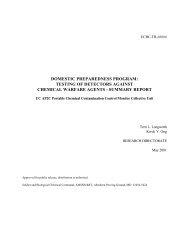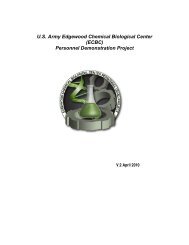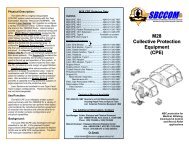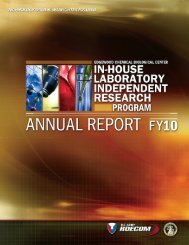(FFPE) with Self-Contained Breathing Apparatus (SCBA) for Rescue
(FFPE) with Self-Contained Breathing Apparatus (SCBA) for Rescue
(FFPE) with Self-Contained Breathing Apparatus (SCBA) for Rescue
You also want an ePaper? Increase the reach of your titles
YUMPU automatically turns print PDFs into web optimized ePapers that Google loves.
While nerve agent exposure can be recognized by observing the reactions of exposed<br />
victims, mustard agent exposure cannot. Symptoms of exposure to mustard (HD) are<br />
latent and may not appear <strong>for</strong> four to 18 hours after exposure. Mustard-exposed victims<br />
may leave the incident scene and may seem relatively unaffected, even several hours after<br />
exposure to significant HD agent concentrations.<br />
4.0 DETERMINING SPECIFIC HAZARDS TO FIREFIGHTERS<br />
A basic factor in determining the hazards faced by firefighters is the vapor concentration that a<br />
firefighter might encounter while per<strong>for</strong>ming rescue or reconnaissance. If a chemical agent<br />
detector capable of accurate near-real-time vapor quantification is not available and/or entry into<br />
an unknown environment <strong>for</strong> detection is not per<strong>for</strong>med, the IC must base hazard assessments on<br />
other indicators, including the signs, symptoms, and reports from escaping victims, and<br />
knowledge of the room size and air handling characteristics.<br />
4.1 Man-In-Simulant Test (MIST) Results<br />
Chemical protective ensembles reduce the exposure of the body to chemical agent vapors<br />
thereby allowing personnel to remain in a contaminated environment <strong>for</strong> longer durations<br />
than they could <strong>with</strong>out protection be<strong>for</strong>e experiencing chemical agent effects. The<br />
MIST measures the amount of agent vapor absorbed by the body (through the skin) while<br />
a protective ensemble is being worn. The increase in protection that the ensemble<br />
provides, above that of an unprotected person, is expressed in the <strong>for</strong>m of a Physiological<br />
Protective Dosage Factor (PPDF). For example, if an unprotected person exposed to a<br />
certain concentration of chemical agent vapor experiences threshold (initial) effects in<br />
one minute, then someone wearing a protective ensemble <strong>with</strong> a PPDF of 10 could be<br />
exposed <strong>for</strong> 10 times as long, or 10 minutes, be<strong>for</strong>e experiencing the same effects.<br />
For vesicants, threshold effects represent the point where the mildest chemical agent<br />
effects occur in the most sensitive part of the body. Depending on the agent, threshold<br />
effects develop either in a localized region, or through total body absorption of agent.<br />
Vapors from vesicants, like mustard (HD), cause reddening of the skin, and eventually<br />
blisters, in localized body regions (local effects). These regions are generally warm,<br />
moist regions of the body, such as the groin and underarms. Alternately, nerve agent<br />
vapors, like sarin (GB), soman (GD), and VX produce systemic effects as a result of total<br />
body absorption.<br />
Calculating the PPDF takes into account the type of agent and the earliest indication of<br />
threshold effects: both systemic and local effects. A single protective ensemble may have<br />
different PPDFs <strong>for</strong> systemic and <strong>for</strong> local threshold effects.<br />
MIST results <strong>for</strong> turnout gear provide PPDFs <strong>for</strong> localized skin effects of HD and<br />
systemic effects of nerve agents. A systemic PPDF (PPDF S ) and a local PPDF (PPDF L )<br />
summarize the overall protective per<strong>for</strong>mance of each type of tested turnout gear. Table<br />
2, below, gives the systemic and local PPDFs <strong>for</strong> each type of turnout gear tested. All<br />
5
















